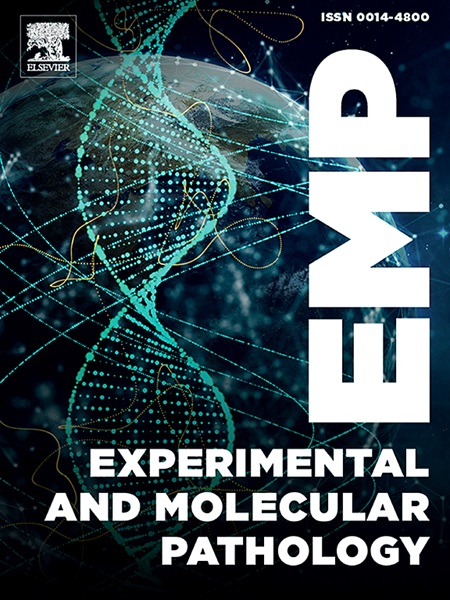m6A demethylase FTO/ALKBH5 promotes diabetes-induced endothelial cell dysfunction by negatively regulating lncRNA H19
IF 3.7
4区 医学
Q2 PATHOLOGY
引用次数: 0
Abstract
Endothelial cell dysfunction induced by glucose is the most important cause of diabetic vascular complications, which are the leading causes of blindness, disability, renal failure, heart failure, stroke, and even death in diabetic patients. RNA m6A modification is involved in the pathogenesis of human disease. However, the role and underlying mechanism of RNA m6A modification in high glucose-induced endothelial cell dysfunction is not well understood. Herein, this study first demonstrated that m6A levels were decreased and that the demethylases FTO and ALKBH5 were upregulated in diabetic patients and an STZ-induced diabetic mouse model. This study revealed that high glucose induced decreased m6A levels and increased expression of FTO and ALKBH5, and silencing of FTO and ALKBH5 restored high glucose-induced decreases in m6A levels and dysfunction of HUVECs. Next, this study systematically screened differentially expressed lncRNAs, including H19, in HUVECs under high glucose conditions. This study revealed that FTO-ALKBH5 inhibited H19 expression by decreasing m6A modification in H19 transcripts. In addition, this study demonstrated the role of the FTO/ALKBH5/H19 pathway in high glucose-induced cellular dysfunction of HUVECs. Ultimately, this study uncovered that silencing of H19 promoted the expression of cell cycle-related genes, including PTEN, p21 and p27 via interacting with EZH2 and affecting the H3K27me3 histone modification. Overall, this study is the first to dissect the regulation of lncRNA by m6A modification in hyperglycaemia, identifying a new regulatory pathway in high glucose-induced cellular dysfunction and providing biomarkers with the potential to serve as therapeutic targets for high glucose-induced cellular dysfunction.
m6A去甲基化酶FTO/ALKBH5通过负调控lncRNA H19促进糖尿病诱导的内皮细胞功能障碍
葡萄糖诱导的内皮细胞功能障碍是糖尿病血管并发症的最重要原因,糖尿病血管并发症是糖尿病患者失明、残疾、肾功能衰竭、心力衰竭、中风甚至死亡的主要原因。RNA m6A修饰参与了人类疾病的发病机制。然而,RNA m6A修饰在高糖诱导的内皮细胞功能障碍中的作用和潜在机制尚不清楚。本研究首先证明糖尿病患者和stz诱导的糖尿病小鼠模型中m6A水平降低,去甲基化酶FTO和ALKBH5上调。本研究发现,高糖诱导m6A水平下降,FTO和ALKBH5表达增加,FTO和ALKBH5沉默可恢复高糖诱导的m6A水平下降和huvec功能障碍。接下来,本研究系统筛选高糖条件下HUVECs中差异表达的lncrna,包括H19。本研究发现FTO-ALKBH5通过降低H19转录本中m6A修饰来抑制H19的表达。此外,本研究还证实了FTO/ALKBH5/H19通路在高糖诱导的HUVECs细胞功能障碍中的作用。最终,本研究发现,沉默H19通过与EZH2相互作用,影响H3K27me3组蛋白修饰,促进PTEN、p21、p27等细胞周期相关基因的表达。总的来说,本研究首次解剖了m6A修饰对lncRNA在高血糖中的调控作用,确定了高糖诱导的细胞功能障碍的新调控途径,并提供了可能作为高糖诱导的细胞功能障碍治疗靶点的生物标志物。
本文章由计算机程序翻译,如有差异,请以英文原文为准。
求助全文
约1分钟内获得全文
求助全文
来源期刊
CiteScore
8.90
自引率
0.00%
发文量
78
审稿时长
11.5 weeks
期刊介绍:
Under new editorial leadership, Experimental and Molecular Pathology presents original articles on disease processes in relation to structural and biochemical alterations in mammalian tissues and fluids and on the application of newer techniques of molecular biology to problems of pathology in humans and other animals. The journal also publishes selected interpretive synthesis reviews by bench level investigators working at the "cutting edge" of contemporary research in pathology. In addition, special thematic issues present original research reports that unravel some of Nature''s most jealously guarded secrets on the pathologic basis of disease.
Research Areas include: Stem cells; Neoangiogenesis; Molecular diagnostics; Polymerase chain reaction; In situ hybridization; DNA sequencing; Cell receptors; Carcinogenesis; Pathobiology of neoplasia; Complex infectious diseases; Transplantation; Cytokines; Flow cytomeric analysis; Inflammation; Cellular injury; Immunology and hypersensitivity; Athersclerosis.

 求助内容:
求助内容: 应助结果提醒方式:
应助结果提醒方式:


